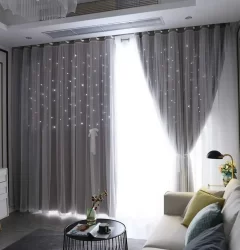Honeycomb blinds, also known as cellular shades, are a type of window covering that feature a unique honeycomb-like structure. They are designed to provide insulation and energy efficiency while maintaining a sleek and stylish appearance.
The honeycomb design of these blinds consists of a series of hexagonal cells, which create air pockets that act as a barrier against heat transfer. The air trapped within the cells helps to regulate the temperature inside a room, keeping it cooler in the summer and warmer in the winter. This thermal insulation property makes honeycomb blinds an excellent choice for energy-conscious individuals who want to reduce their heating and cooling costs.
Honeycomb blinds are typically made from lightweight, durable materials such as polyester or other fabrics. They are available in various cell sizes, ranging from single-cell to double-cell or even triple-cell designs. The size of the cells affects the level of insulation provided, with larger cells generally offering better insulation.
These blinds are also known for their light-filtering and privacy features. Depending on the fabric and opacities chosen, honeycomb blinds can allow natural light to enter a room while still providing privacy from the outside. Some varieties of honeycomb blinds offer blackout options, which completely block out light for rooms where complete darkness is desired, such as bedrooms or home theaters.
Honeycomb blinds come in a wide range of colors, patterns, and textures, allowing you to find an option that complements your home decor. They can be operated using various control mechanisms, including cordless options for enhanced safety and convenience. Some models even offer motorized controls, allowing you to open, close, or adjust the blinds with the push of a button or through smart home integration.
Overall, honeycomb blinds are an attractive window covering choice that offers insulation, light control, privacy, and style. They are popular for both residential and commercial applications due to their versatility and energy-efficient properties.






